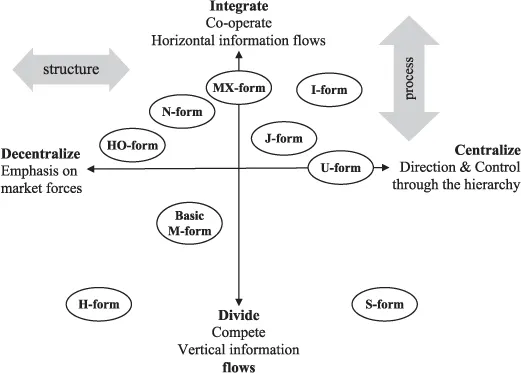1.1. EVOLUTION OF ORGANIZATIONAL STRUCTURES AND ORGANIZATIONAL MANAGEMENT MODELS
The development stage where a company operates, the nature of its operations and the ownership structure are the main, but not the only, factors that have influence on the choice of a unit’s organizational model and determines its management model. The simplest organizational forms can be found in micro-enterprises, where making strategic and operational decisions, direct task delegation, and bearing full responsibility rests with the owner. The level of cooperation between employees in this model of organization is usually low. The organizational structure changes with enterprise development, the increasing number of employees, the activity scale, both in the objective area, that is, the number of products and services provided, as well as in the subjective area, that is, the number of customers or markets where the enterprise operates. Increasing number of employees makes it necessary to introduce intermediate levels of organization management or its separate part, for example, by area or product. This way, strategic management, reserved for top management, is separated from operational management, that is shifted to lower decision-making levels. This solution requires efficient information flow within the organization as well as resource sharing. Any organizational structure remodeling that takes place in the organization is primarily focused on effectiveness increase, which is widely understood here by optimizing own resources, providing greater operation flexibility and ultimately better communication with customers. Building multi-department organizational structures requires adjusting the strategy, structure, and processes to evolving environment in which the company operates (Chandler, 1962). In case of modeling multi-level organizational structures, Herbert and Seal point out there is a “boss dilemma” which means maintaining a balance between the autonomy of undertaken operational decisions and the management efficiency of the organization as a whole and avoiding internal competition among individual company departments. The main dilemma is related to the determination of the autonomy scope of individual departments in the process of making operational decisions and the scope of control and direct interference in the decision-making processes by top-level management. The key challenge that the management is about to face is to ensure the optimal flow of information within the organization and to create proper conditions for knowledge sharing and collaboration between various departments in achieving the objectives of the entire organization (Herbert & Seal, 2010). The basic form of multi-departmental organization assumes that individual departments are more effective when they directly respond to market needs in their activity areas (Fig. 1).
Fig. 1. The Basic B-form.
Source: Herbert and Seal (2010, p. 3).
In order to establish appropriate relationship between strategy, structure and business profile, the manager must first determine what is the market strategy of the company. It should be noted that the market strategy of every company is unique to some extent. However, according to researchers from the University of Colorado, Colorado-Springs, there are four basic market strategies, which, among other things, determine the selection of organizational structure: prospectors, analyzers, low cost defenders and differentiated defenders (Olson, Slaterb, & Hultc, 2005). The departmental organizational structure is a kind of interaction of vertical and horizontal information and management flows. In practice, as Herbert and Seal indicate that there is a variety of departmental organizational structures. Organizational models worth mentioning here are the following (Herbert & Seal, 2010, pp. 3–7):
the Independent, I-form – an organization that operates globally or internationally in the market and seeks to control and supervise the entire production process, for example, oil extraction, processing and distribution companies.
Holdings, H-form – organizations that involve companies that operate in different markets and provide different products and services – running diversified businesses under one common corporate umbrella.
the Unitary, U-form – an organizational structure with centralized control approach, as in case of basic forms of organizational structures (where the decision-making process is centralized), but primarily used for large companies. The size of an enterprise requires to create a specific human resource functions to support decision-making processes and their control. This form of organization was developed in the 1970s, where computers introduced on massive scale, supported management processes that enabled rapid processing of huge amounts of data. Organizational structures of this type featured a high level of bureaucracy and low flexibility for market needs.
The “Horizontal Organization,” HO-form – the autonomy of the departments in these types of organization enables sharing knowledge and resources to solve business problems. The information flow in such organizations is horizontal.
The “Joined-up” company, J-form – individual departments within the organization are formally and informally linked. This solution increases the flexibility of the company operations by better interaction with its clients, among other things. Implementation of this type of organization requires process standardization.
The Matrix, MX-form – an organizational form where department cross-relationships are not so strict and the level of mutual cooperation and integration is gradually increasing. It is a model developed by the ABB conglomerate.
The New (or novelty), N-form – another more and more decentralized form of organization, where employees operate in “loose” structures, are willing to share their knowledge and pursue common goals.
The forms of company organization discussed above are the combination of a decision-making process and the centralization or decentralization of the organizational structure (Fig. 2).
The review of available forms of enterprise organization allows for their systemization based on the formalization level of internal organizational structures and the decision-making process as well as the cooperation level of employees in achieving the organization objectives. The complex nature of manufactured products or provided services imposes the necessity for mutual cooperation of individual departments or their operating units.
Fig. 2. Organization Design Options.
Source: Herbert and Seal (2010, p. 6).
Therefore, is the public sector subject to the same dependencies and organizational problems as the private sector?
To answer this question, the changes and developments in the public sector over the last decades shall be presented. S. Osborne widely expressed his opinion on public administration and public management reform. For the public sector he pointed out the need to implement good practices coming from the private sector (Osborne & Gaebler, 1992). The sources of problems within traditional model of public management on Webber-based administration organization can be seen in the mid-twentieth century, intensified by the fuel and economic crisis (Kisner & Vigoda-Gadot, 2017). The transformation from the administration of public administration institutions to public management took place simultaneously in the United States and Western European countries in the early 80s of the twentieth century and was defined by British and Australian researchers and is now commonly known as: New Public Management (NPM) (Hood, 1991). Moreover, the NPM was based on fundamentally different assumptions than in the previous reforms of the 50s and 60s of the twentieth century. Firstly, the administration reform was focused on technical and legal, not political, assumptions. Secondly, the reform was implemented in different countries on a national or sector level. In its assumptions, NPM focuses on effectiveness, efficiency and a “business” approach, which was to be the cure for quality improvement of public services. Pollitt and Bouckaert (2011, pp. 5–11) defined NPM as a package of the following concepts and practices:
more focus on productivity, especially with the use of measurable indicators;
preferring lean, flat, small and specialized organizational structures as opposed to large, complex and multi-functional ones;
common substitution of contracts with hierarchical relations treated as an essential tool for the coordination of provided services;
wide introduction of market mechanisms, including internal competition, to increase public sector efficiency; and
focusing on the recipient of provided services and treating them as a client; implementing tools such as total quality management.
The key to success according to the NPM concept is competition and the introduction of market mechanism in the implementation of public services (Christensen & Laegreid, 2011). To quote a British politician, Stephen Dorrell, Secretary of State in John Major’s Cabinet, “where it is not possible to improve the public sector efficiency, this part of provided services should be privatised” (Pollitt & Bouckaert, 2011, p. 9). In the subject literature there are other elements of the NPM concept that are based on similar features (Andrisani, Hakim, & Savas, 2002):
emphasis on the statutory objectives of a unit and omitting the remaining tasks, thus adjusting the size of the organizational units according to basic tasks;
decentralization of management and delegation of decision-making process to lower levels;
implementation of efficiency measures, evaluation of results as elements of management performance assessment, including but not limited to monitoring the satisfaction of residents – recipients of services;
implementation of market mechanisms; and
increasing (rebuilding) public confidence levels.
The pioneers in NPM implementation were, among others, the following countries: United States, United Kingdom, New Zealand and Australia (Haque). Basically, the reforms implemented in the UK by Margaret Thatcher, or subsequent reforms implemented by the governments of the United States, Australia and New Zealand were characterized by common assumptions (Table 1), which are commonly known in subject literature as NPM (Dunsire, 1995).
The implementation of NPM-based reforms in OECD countries resulted in the development of individual concepts. Subject literature can list many national NPM models, that is, French model (Bartoli, 2008) and New Zealand model (Boston et al. 1995). Then, Pollitt and Bouckaert recall many other models including: German “slim state” model, Belgian “Copernicus” model or the Neo-Weberian State (NWS). The development of digital technologies lays the foundations for the next evolution of the NPM approach toward Digital-Era Governance (DEG) (Dunleavy, Margetts, Bastow, & Tinkler, 2006). Criticism of classical NPM assumptions led to concept evolution toward the involvement of all parties in the management of processes – New Public Governance (NPG) (Osborne, 2006). The analysis of existing models allowed for the development of main varieties of this direction of public administration reforms. Among the most popular models there are four NPM models developed by E. Ferlie, L. Ashburner, L. Fitzgerald and A. Pettigrew. T...


